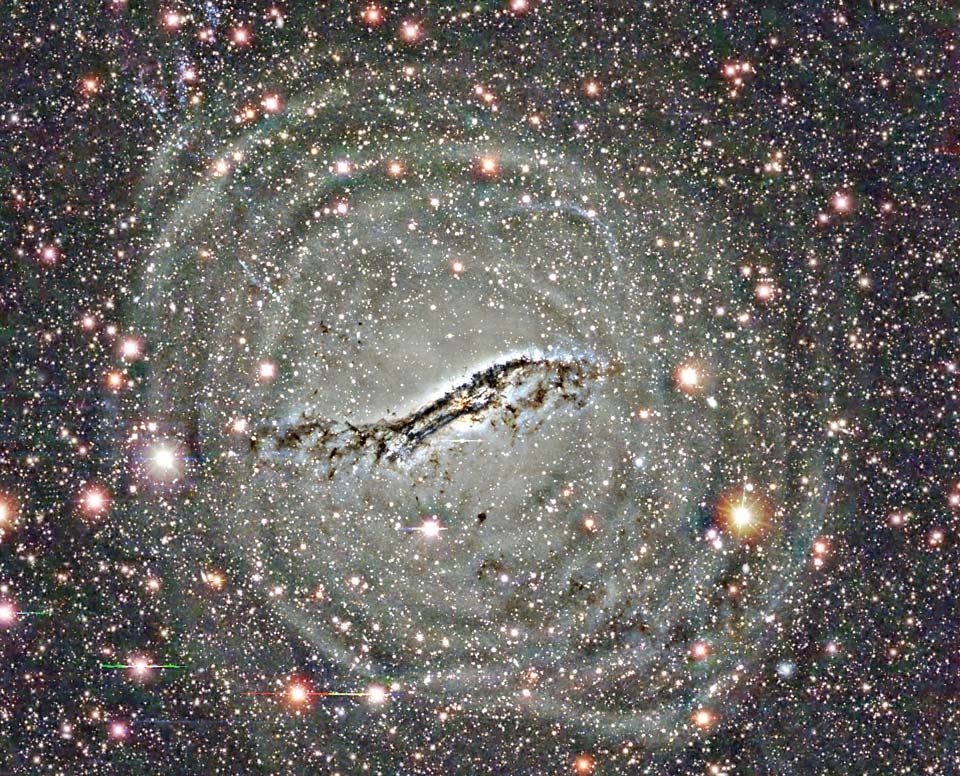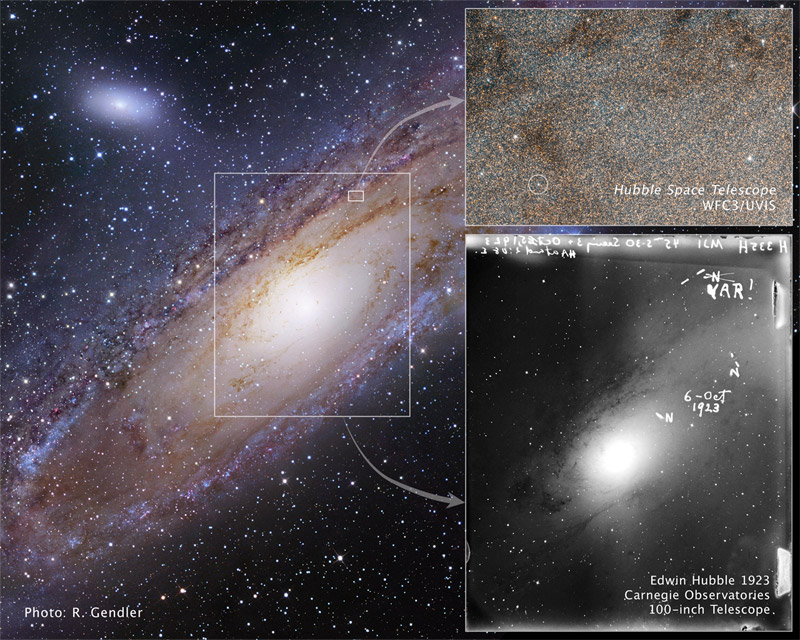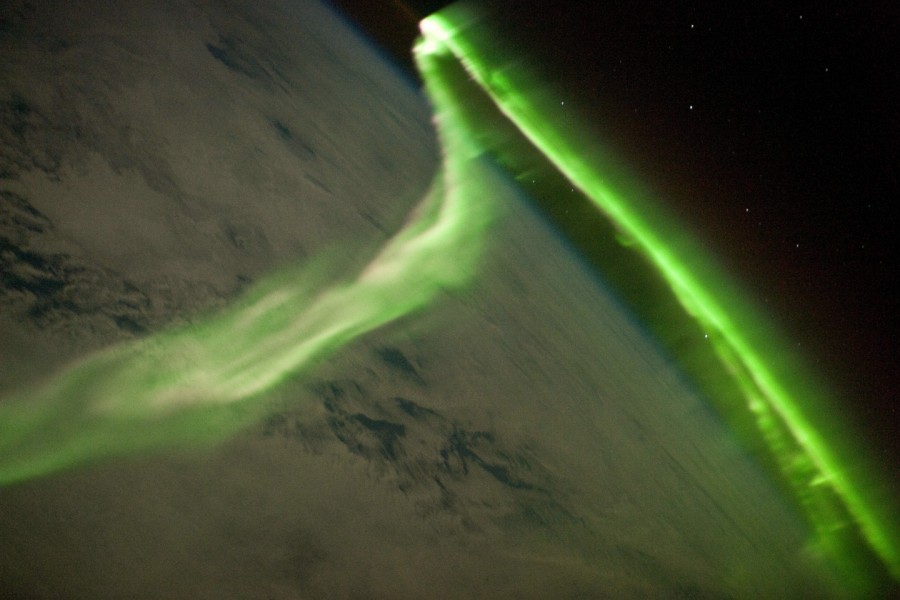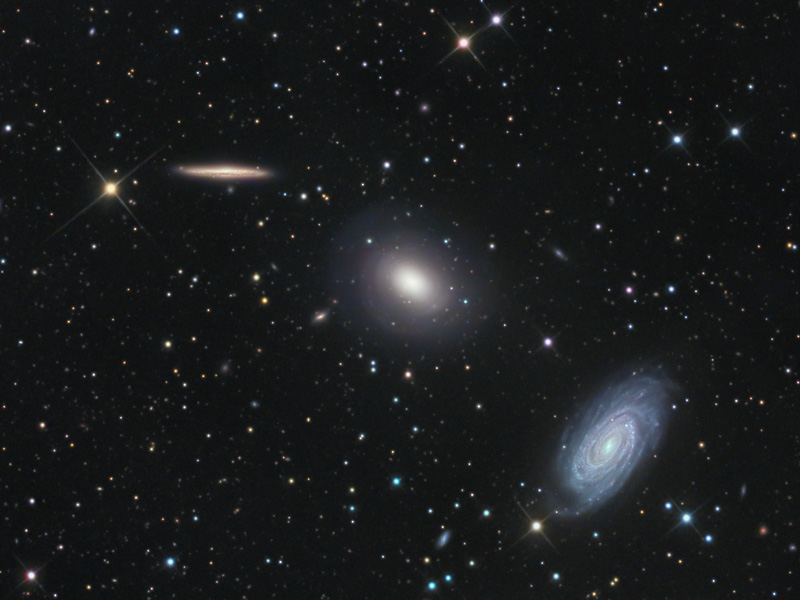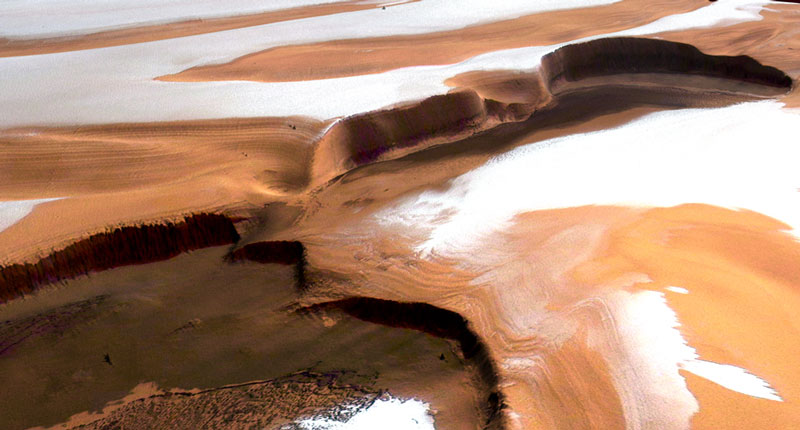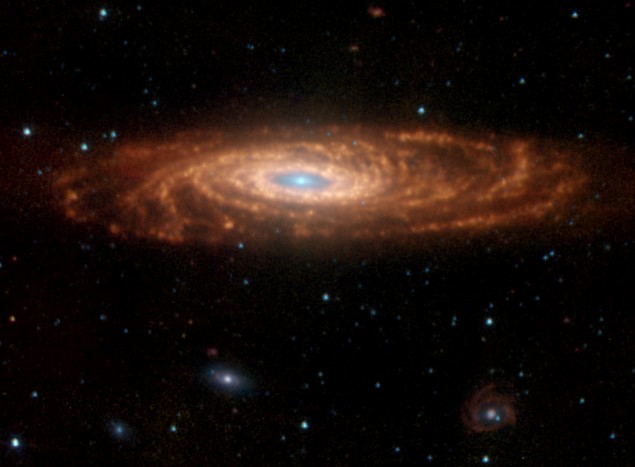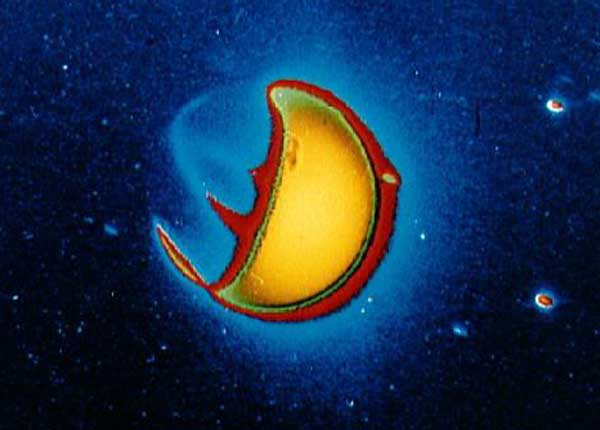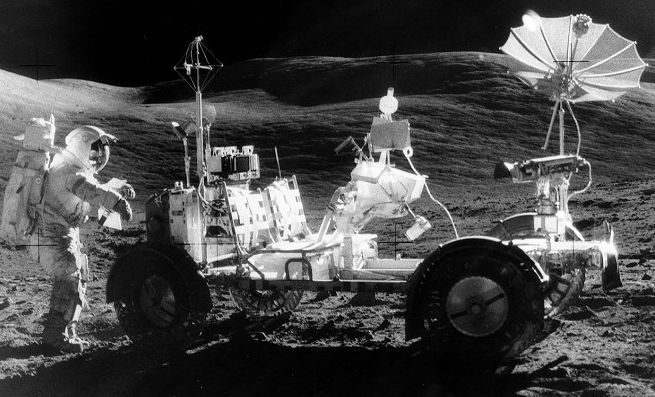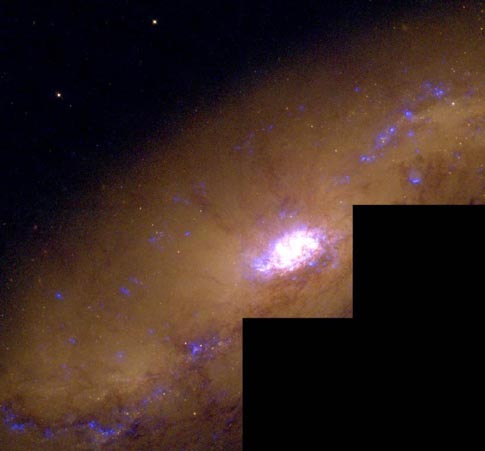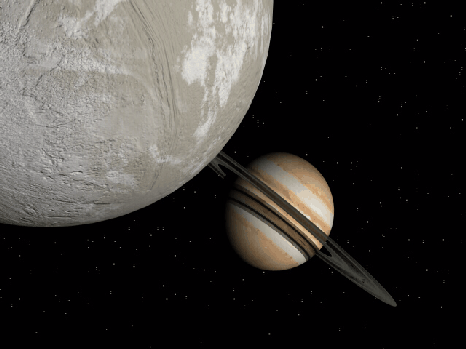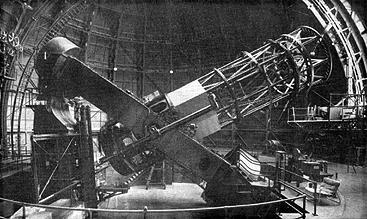| << Previous | Index | Next >> |
2015 Have you seen the passing planets yet? Today the planets Jupiter and Venus pass within half a degree of each other as seen from Earth. This conjunction, visible all over the world, is quite easy to see -- just look to the west shortly after sunset. The brightest objects visible above the horizon will be Venus and Jupiter, with Venus being the brighter of the two. Featured above, the closing planets were captured two nights ago in a sunset sky graced also by high-level noctilucent clouds. In the foreground, the astrophotographer's sister takes in the vista from a bank of the Sec Reservoir in the Czech Republic. She reported this as the first time she has seen noctilucent clouds. Jupiter and Venus will appear even closer together tonight and will continue to be visible in the same part of the sky until mid-August.
2014 Some stars explode in slow motion. Rare, massive Wolf-Rayet stars are so tumultuous and hot that they slowly disintegrating right before our telescopes. Glowing gas globs each typically over 30 times more massive than the Earth are being expelled by violent stellar winds. Wolf-Rayet star WR 124, visible near the above image center spanning six light years across, is thus creating the surrounding nebula known as M1-67. Details of why this star has been slowly blowing itself apart over the past 20,000 years remains a topic of research. WR 124 lies 15,000 light-years away towards the constellation of Sagitta. The fate of any given Wolf-Rayet star likely depends on how massive it is, but many are thought to end their lives with spectacular explosions such as supernovas or gamma-ray bursts.
2013
Click to play embedded YouTube video.
Image Credit & Copyright: Robert Nemiroff (MTU)
2012 What causes the surrounding shells in peculiar galaxy Cen A? In 2002 a fascinating image of peculiar galaxy Centaurus A was released, processed to highlight a faint blue arc indicating an ongoing collision with a smaller galaxy. Another interesting feature of Cen A, however, is the surrounding system of shells, better visible here in this recently released wider pan from the four meter Blanco telescope at Cerro Tololo Inter-American Observatory. Faint shells around galaxies are not unusual and considered by themselves as evidence of a previous galaxy merger, analogous to water ripples on a pond. An unexpected attribute of these shells is the abundance of gas, which should become separated from existing stars during the collision.
2011 In the 1920s, examining photographic plates from the Mt. Wilson Observatory's 100 inch telescope, Edwin Hubble determined the distance to the Andromeda Nebula, decisively demonstrating the existence of other galaxies far beyond the Milky Way. His notations are evident on the historic plate image inset at the lower right, shown in context with ground based and Hubble Space Telescope images of the region made nearly 90 years later. By comparing different plates, Hubble searched for novae, stars which underwent a sudden increase in brightness. He found several on this plate, indicating their position with lines and an "N". Later, discovering that the one near the upper right corner was actually a type of variable star known as a cepheid, he crossed out the "N" and wrote "VAR!". Thanks to the work of Harvard astronomer Henrietta Leavitt, cepheids, regularly varying pulsating stars, could be used as standard candle distance indicators. Identifying such a star allowed Hubble to show that Andromeda was not a small cluster of stars and gas within our own galaxy, but a large galaxy in its own right at a substantial distance from the Milky Way. Hubble's discovery is responsible for establishing our modern concept of a Universe filled with galaxies.
2010 On May 29, looking southward from a vantage point about 350 kilometers above the southern Indian Ocean, astronauts onboard the International Space Station watched this enormous, green ribbon shimmering below. Known as aurora australis or southern lights, the shifting, luminous bands are commonly seen at high northern latitudes as well, there known as the aurora borealis or northern lights. North or south their cause is the same though, as energetic charged particles from the magnetosphere pile into the atmosphere near the Earth's poles. To produce the characteristic greenish glow, the energetic particles excite oxygen atoms at altitudes of 100 kilometers or more. Aurora on May 29 were likely triggered by the interaction of the magnetosphere with a coronal mass ejection erupting from the Sun on May 24.
2009 This intriguing trio of galaxies is sometimes called the Draco Group, located in the northern constellation of (you guessed it) Draco. From left to right are edge-on spiral NGC 5981, elliptical galaxy NGC 5982, and face-on spiral NGC 5985 -- all within this single telescopic field of view spanning a little more than half the width of the full moon. While the group is far too small to be a galaxy cluster and has not been cataloged compact group, these galaxies all do lie roughly 100 million light-years from planet Earth. On close examination with spectrographs, the bright core of the striking face-on spiral NGC 5985 shows prominent emission in specific wavelengths of light, prompting astronomers to classify it as a Seyfert, a type of active galaxy. Not as well known as other tight groupings of galaxies, the contrast in visual appearance makes this triplet an attractive subject for astrophotographers. This impressively deep exposure of the region also reveals faint and even more distant background galaxies.
2008 Wisps like this are all that remain visible of a Milky Way star. About 7,500 years ago that star exploded in a supernova leaving the Veil Nebula, also known as the Cygnus Loop. At the time, the expanding cloud was likely as bright as a crescent Moon, remaining visible for weeks to people living at the dawn of recorded history. Today, the resulting supernova remnant has faded and is now visible only through a small telescope directed toward the constellation of Cygnus. The remaining Veil Nebula is physically huge, however, and even though it lies about 1,400 light-years distant, it covers over five times the size of the full Moon. In images of the complete Veil Nebula, studious readers should be able to identify the Pickering's Triangle component pictured above, a component named for a famous astronomer and the wisp's approximate shape. The above image is a mosaic from the 4-meter Mayall telescope at the Kitt Peak National Observatory located in Arizona, USA.
2007 Vertical cliffs of nearly two kilometers occur near the North Pole of Mars. Also visible in the above image of the Martian North Polar Cap are red areas of rock and sand, white areas of ice, and dark areas of unknown composition but hypothesized to be volcanic ash. The cliffs are thought to border volcanic caldera. Although the sheer drop of the Martian cliffs is extreme, the drop is not as deep as other areas in our Solar System, including the 3.4-kilometer depth of Colca Canyon on Earth and the 20 kilometer depth of Verona Rupes on Uranus' moon Miranda. The above image, digitally reconstructed into a perspective view, was taken by the High Resolution Stereo Camera on board the ESA's robotic Mars Express spacecraft currently orbiting Mars.
2006 Binary star system GRO J1655-40 consists of a relatively normal star about twice as massive as the Sun co-orbiting with a black hole of about seven solar masses. This striking artist's vision of the exotic binary system helps visualize matter drawn from the normal star by gravity and swirling toward the black hole. But it also includes a wind of material escaping from the black hole's accretion disk. In fact, astronomers now argue that Chandra Observatory x-ray data indicate a high-speed wind is being driven from this system's disk by magnetic forces. Internal magnetic fields also help drive material in the swirling disk into the black hole itself. If you had x-ray eyes as good as Chandra's, you could find GRO J1655-40 about 11,000 light-years away in the constellation Scorpius.
2005 Fomalhaut (sounds like "foam-a-lot") is a bright, young, star, a mere 25 light-year trip from planet Earth in the direction of the constellation Piscis Austrinus. Earlier infrared observations identified a torus of cold material surrounding the nearby star but the panels above detail the sharpest ever visible light-image of Fomalhaut's dusty debris ring, recorded by the Hubble Space Telescope's ACS camera. Overwhelming glare from the star is masked by an occulting disk in the camera's coronagraph. The off-center ring with a sharp inner boundary is taken to be strong evidence of a massive planet orbiting far from Fomalhaut, shaping and maintaining the ring's inner edge. Starting 133 astronomical units (Earth-Sun distances) from Fomalhaut, the dusty ring itself is likely a larger, younger analog of our own Kuiper Belt - the solar system's outer reservoir of icy bodies.
2004 If our own Milky Way galaxy were 50 million light-years away with its disk inclined slightly to our line of sight, it would look a lot like large spiral galaxy NGC 7331. In fact, seen here in a false-color infrared image from the Spitzer Space Telescope, NGC 7331 is interesting in part because it is thought to be so similar to the Milky Way. Light from older, cooler stars, shown in blue, dominates the central bulge of NGC 7331, while Spitzer data also indicates the presence of a black hole within this galaxy's central regions - about the same size as the black hole at our own galactic core. Shown in red and brown, radiation from complex molecules associated with dust traces NGC 7331's star forming spiral arms. The arms span around 100,000 light-years, about the size of the Milky Way. Curiously, a further star forming ring is visible in yellowish hues, 20,000 light-years or so from the center of NGC 7331, but it is not known if such a structure exists within our own galaxy.
2003 Why is Phobos so dark? Phobos, the largest and innermost of two Martian moons, is the darkest moon in the entire Solar System. Its unusual orbit and color indicate that it may be a captured asteroid composed of a mixture of ice and dark rock. The above picture was captured recently by the robot spacecraft Mars Global Surveyor (MGS) orbiting Mars. Phobos is a heavily cratered and barren moon, with its largest crater located on the far side. From MGS images like this, Phobos has been determined to be covered by perhaps a meter of loose dust. Phobos orbits so close to Mars that from some places it would appear to rise and set twice a day, but from other places it would not be visible at all. Phobos' orbit around Mars is continually decaying -- it will likely break up with pieces crashing to the Martian surface in about 50 million years.
2002 The nebula surrounding bright star S Mon is filled with dark dust and glowing gas. The strange shapes originate from fine interstellar dust reacting in complex ways with the energetic light and hot gas being expelled by the young stars. The region just below S Mon, the bright star in the above picture, is nicknamed the Fox Fur Nebula for its color and texture. The blue glow directly surrounding S Mon results from reflection, where neighboring dust reflects light from the bright star. The more diffuse red glow results from emission, where starlight ionizes hydrogen gas. Pink areas are lit by a combination of the two processes. S Mon is part of a young open cluster of stars named NGC 2264, located about 2500 light years away toward the constellation of Monoceros, just north of the Cone Nebula.
2001 This might resemble a fried egg you've had for breakfast, but it's actually much larger. In fact, ringed by blue-tinted star forming regions and faintly visible spiral arms, the yolk-yellow center of this face-on spiral galaxy, NGC 7742, is about 3,000 light-years across. About 72 million light-years away in the constellation Pegasus, NGC 7742 is known to be a Seyfert galaxy - a type of active spiral galaxy with a center or nucleus which is very bright at visible wavelengths. Across the spectrum, the tremendous brightness of Seyferts can change over periods of just days to months and galaxies like NGC 7742 are suspected of harboring massive black holes at their cores. This beautiful color picture is courtesy of the Hubble Space Telescope Heritage Project.
2000 Here's a switch: the above picture is of the Earth taken from a lunar observatory! This false color picture shows how the Earth glows in ultraviolet (UV) light. UV light is so blue humans can't see it. Very little UV light is transmitted through the Earth's atmosphere but what sunlight does make it through can cause a sunburn. The Far UV Camera / Spectrograph deployed and left on the Moon by the crew of Apollo 16 took the above picture. The part of the Earth facing the Sun reflects much UV light, but perhaps more interesting is the side facing away from the Sun. Here bands of UV emission are also apparent. These bands are the result of aurorae and are caused by charged particles expelled by the Sun.
1999 In December of 1972, Apollo 17 astronauts Eugene Cernan and Harrison Schmitt spent about 75 hours exploring the Moon's Taurus-Littrow valley while colleague Ronald Evans orbited overhead. Cernan and Schmitt were the last humans to walk or ride on the Moon - aided in their explorations by a Lunar Roving Vehicle. The skeletal-looking lunar rover was just over 10 feet long, 6 feet wide and easily carried astronauts, equipment, and rock samples in the Moon's low gravity (about 1/6 Earth's). In this picture, Cernan stands at the back of the rover which carried the two astronauts in lawn-chair style seats. An umbrella-shaped high gain antenna and TV camera are mounted in the front. Powered by four 1/4 horsepower electric motors, one for each wheel, this rover was driven a total of about 18 miles across the lunar surface. Its estimated top speed was nearly 8 miles per hour.
1998 NGC 1808 is a galaxy in turmoil. A barred spiral with marked similarities to our home Milky Way Galaxy, NGC 1808 is distinguished by a peculiar nucleus, an unusually warped disk, and strange flows of hydrogen gas out from the central regions. Amidst all of this, NGC 1808 is undergoing so much star formation it has been deemed a starburst galaxy. In the above color-enhanced photograph, regions of active star formation and shown by their blue glow. Here bright blue stars have recently formed and are energizing large clouds of surrounding hydrogen gas. The reddish brown regions indicate dense interstellar dust. NGC 1808 is a relatively close 40 million light-years away, and stretches about 35,000 light-years across. The peculiar state of NGC 1808 may be caused by the gravity of neighboring galaxy NGC 1792.
1997 You're zipping through the Solar System when you pass ... asteroid 253 Mathilde. This actually happened to NASA's NEAR spacecraft just last Friday. The above picture of the previously unresolved asteroid was released just yesterday. Mathilde's large craters and irregular shape indicates that it has undergone huge collisions with other large space rocks in the past. Mathilde has more large craters than asteroids 243 Ida and 951 Gaspra, which were photographed by the Galileo spacecraft now orbiting Jupiter. In the image center is a crater over 20 kilometers across. Asteroids are rare enough so that spacecraft traveling through even the main asteroid belt need not fear colliding with any - let alone one as large as Mathilde.
1996 Within the last few years, observational astronomy has given humanity evidence of the existence of worlds beyond the solar system. Indeed, solar-type stars are now inferred to harbor planets of approximately Jupiter mass - some residing in temperature zones which could conceivably support liquid water and therefore life! Above is a hypothetical scene near one such planet whose sun, 47 Ursae Majoris (47 UMa), is a yellow dwarf star (spectral class G0 V) very similar to our own. In our sky, it appears as a faint, inconspicuous star below the cup of the northern hemisphere asterism, "the Big Dipper". (Our own sun would be equally inconspicuous when viewed from 47 UMa ...) Astronomer's G. Marcy and P. Butler announced the discovery of a planet associated with this star in 1996 and reported it to have a mass of about 2.4 Jupiters or more with an orbital period of 3 years. This artist's vision pictures the detected planet, referred to as 47 UMa b, as a gas giant surrounded by a ring of material - analogous to our own gas giant Saturn. In the foreground lies a hypothetical moon of 47 UMa b. Could such a moon support life? 47 UMa is only 44 light years distant, fairly close by astronomical standards - yet there is evidence for planetary systems which are closer still. NASA plans to explore nearby planetary systems using spaceborne observatories.
1995 In the 1920s, pictures from the Hooker Telescope on Mt. Wilson fundamentally changed our understanding of the cosmos. Astronomer Edwin Hubble, using photographs he took with this telescope, demonstrated that the objects his contemporaries called "spiral nebulae" were actually huge systems of stars - spiral galaxies, similar to our own Milky Way galaxy but incredibly distant. Prior to Hubble's work it was argued that the spiral nebulae were mere clouds of gas and that they, along with everything else in the universe, were contained in our own galaxy. The Hooker Telescope mirror is 100 inches in diameter which is nearly the size of the mirror of the orbiting Hubble Space Telescope named in Hubble's honor. The Mount Wilson Observatory offers a "virtual walking tour" of this historic telescope.
| << Previous | Index | Next >> |


